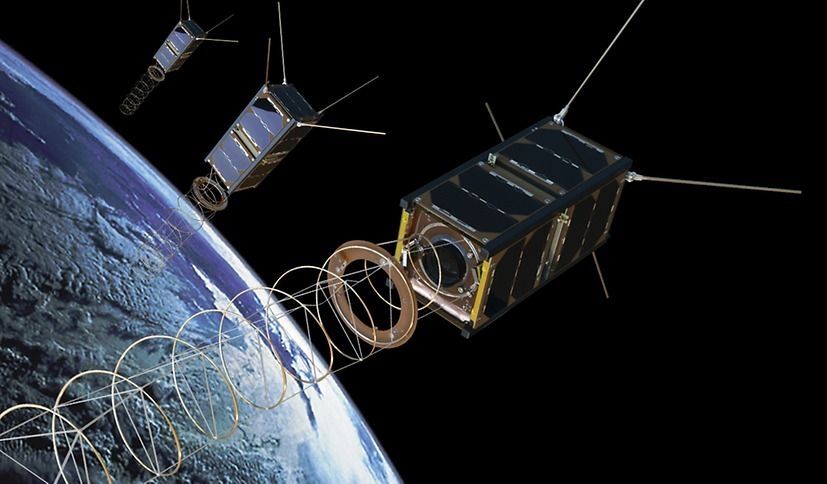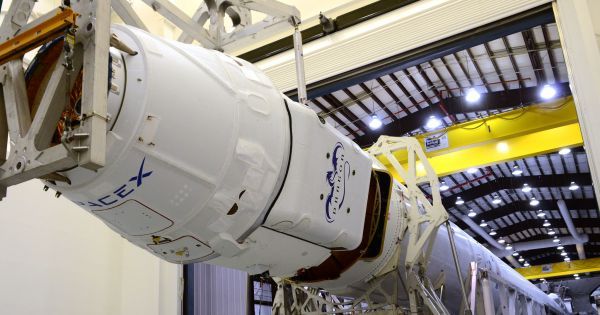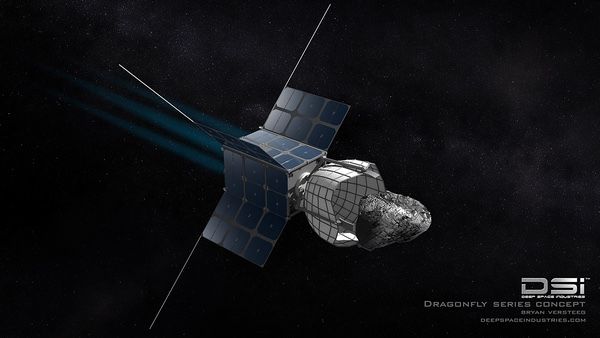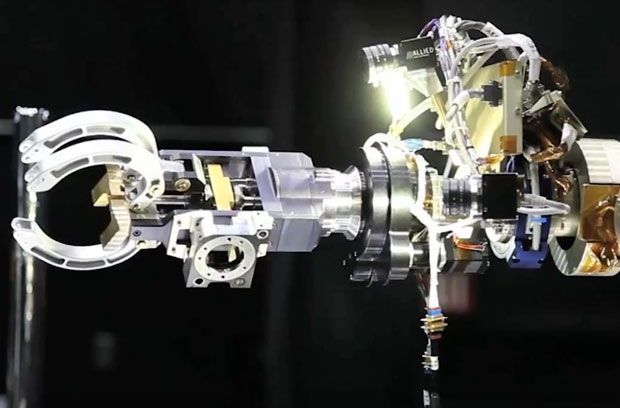BridgeSat’s turnkey solution connects satellites to the ground accommodating the greater demand for accurate and frequent data collection from LEOs.


RT has released the first-ever 360-degree footage shot by man in outer space, putting viewers in the shoes of two Russian cosmonauts launching nanosatellites from outside the International Space Station (ISS).
The video, which shows out-of-this-world views of Planet Earth, is the first time that the so-called extravehicular activity (EVA) has been filmed in 360. The immersive new format previously helped viewers explore the ISS modules as part of the Space 360 project.
Cosmonauts Sergey Ryazansky and Fedor Yurchikhin captured the breathtaking scenery while doing their 7.5-hour spacewalk in August, which included maintenance tasks and the launch of five miniature satellites.

Washington (AP) — Seated before the grounded space shuttle Discovery, a constellation of Trump administration officials used soaring rhetoric to vow to send Americans back to the moon and then on to Mars.
After voicing celestial aspirations, top officials moved to what National Intelligence Director Dan Coats called “a dark side” to space policy. Coats, Vice President Mike Pence, other top officials and outside space experts said the United States has to counter and perhaps match potential enemies’ ability to target U.S. satellites.
Pence, several cabinet secretaries and White House advisers gathered in the shadow of the shuttle at the Smithsonian Institution’s Steven F. Udvar-Hazy Center to chart a new path in space — government, commercial and military — for the country. It was the first meeting of the National Space Council, revived after it was disbanded in 1993.

Every 100 years or so, our Sun gives off a great big belch that sends an intense wave of charged particles towards Earth. This wasn’t a problem in the past, but our high-tech civilization is now disturbingly vulnerable to these solar storms. A new study quantifies the economic risks posed by these extreme solar storms, while also proposing a super-futuristic solution to the problem: an Earth-sized shield built in outer space.
The term “solar storm” is used to identify the various nasties the Sun can hurl our way, including x-rays, charged particles, and magnetized plasma. In 1859, a series of powerful coronal mass ejections (CMEs) hit our planet head on, disrupting telegraph stations and causing widespread communication outages. If we were to be hit by an equally powerful solar storm today, it would knock out satellites and electrical grids, disrupting global communications, transportation, and supply chains. Total worldwide losses could reach up to $10 trillion, with recovery taking many years.

GomSpace Group, a company listed on the Nasdaq First North Premier exchange, and the Luxembourg Economy Ministry agreed in principle to establish in the country a company focused on satellite operations and data processing and distribution.
By 2021 the company could employ up to 50 full-time staff, GomSpace said in a statement. The ministry will provide funding through its Luxembourg space programme as well as grants for research and development that will happen in the country, it said.
“By choosing the Grand-Duchy for their international expansion, GomSpace acknowledges the substantial efforts of the government over the last years to put in place the necessary measures to support the continued strengthening and diversification of its space sector,” Economy Minister Etienne Schneider said.


For the first time, researchers have sent a quantum-secured message containing more than one bit of information per photon through the air above a city. The demonstration showed that it could one day be practical to use high-capacity, free-space quantum communication to create a highly secure link between ground-based networks and satellites, a requirement for creating a global quantum encryption network.
Quantum encryption uses photons to encode information in the form of quantum bits. In its simplest form, known as 2D encryption, each photon encodes one bit: either a one or a zero. Scientists have shown that a single photon can encode even more information—a concept known as high-dimensional quantum encryption—but until now this has never been demonstrated with free-space optical communication in real-world conditions. With eight bits necessary to encode just one letter, for example, packing more information into each photon would significantly speed up data transmission.
“Our work is the first to send messages in a secure manner using high-dimensional quantum encryption in realistic city conditions, including turbulence,” said research team lead, Ebrahim Karimi, University of Ottawa, Canada. “The secure, free-space communication scheme we demonstrated could potentially link Earth with satellites, securely connect places where it is too expensive to install fiber, or be used for encrypted communication with a moving object, such as an airplane.”
China and Russia are set to sign a milestone agreement in October on joint space exploration from 2018 to 2022, sending manned missions to the Moon for the first time. The bilateral agreement will cover five areas including lunar and deep space exploration, developing special materials, collaboration in the area of satellite systems, Earth remote sensing, and space debris research. This is the first bilateral agreement to cover a partnership spanning five years. It is to be signed against the background of space exploration race the US is trying to win, so the two partners decided to join the efforts. In February, the Trump administration asked NASA to look into the possibility of manning a heavy-lift rocket mission, expected to be launched in 2018, setting the stage for a human return to the Moon.
Russia’s Glavkosmos space launch operator is also working with Chinese partners on joint experiments aboard the International Space Station (ISS). China was interested in buying the world’s most powerful Russian-made RD rocket engines produced by Energomash while Russian Space Systems showed interest in Chinese electronic technology.
The first module of China’s space station Beijing is expected to be launched in 2018. The project is to be completed in 2022. According to the plans, a Chinese mission will be sent to Mars in 2020 to land a robot vehicle for scientific research. Last year, Beijing put into operation the world’s largest radio telescope half a kilometer (0.3 miles) in diameter. In 2014, China caught up with Russia having launched about the same number of satellites – 117 (72% increase in 2011–14). Russia had 118 launched by the time (the number increased by 20% during the same period).

Dear vice president mike pence, chairman of the national space council:
Thank you for your leadership of the National Space Council that has been recreated under the authority of President Trump. In 1962, when the Council was first formed under the leadership of Vice President Johnson, its executive director, Edward Welsh, played a decisive role in the drafting and passage of the Communications Satellite Act, which led to the creation of COMSAT and the subsequent formation of INTELSAT, an intergovernmental communications satellite organization initially with 14-member governments in 1964 that was privatized in 2001. COMSAT was the first major step towards the commercial use of outer space. In 1967, after Johnson had been elected president, he reported that “the Communications Satellite Act of 1962 [has] brought mankind to the threshold of a full-time global communications service to which all nations of the world may have equal access.”
The world is at a watershed moment regarding outer space. Governments have dominated in outer space. Increasingly, though, private investment will shape the future in space. The US does not have a strategy nor is it organized to effective ly advance private space development and the emergence of a self-sustaining space economy. This is the principal challenge to be addressed by the Space Council.

Let’s say you are the program manager of a very large, complex system. Perhaps it’s an aircraft, or a building, or a communications network. Your system is valued at over US $500 million. Could you imagine being told that you won’t ever be able to maintain it? That once it’s operational, it will never be inspected, repaired, or upgraded with new hardware?
Welcome to the world of satellite building. After a satellite is launched, it is on a one-way journey to disrepair and obsolescence, and there is little anyone can do to alter that path. Faults (which are called anomalies in the space business) can only be diagnosed remotely, using data and inferential reasoning. Software fixes and upgrades may be possible, but the nuts and bolts remain untouched. The upshot: Even if a satellite is operating well, it could lose its state-of-the-art status just a few years into a typical 15-year lifetime.
If governments and private companies could actively repair and revitalize their satellites in geosynchronous orbit—and move them to new orbits as needed—they could extend the lifespans of their investments and substantially defer the cost of building and launching replacements.